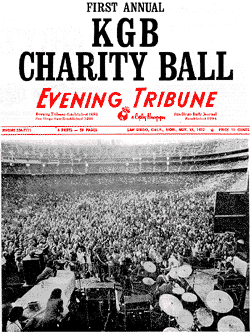|
www.reelradio.com

by Ron Jacobs
©1972,1997-2007 by Ron Jacobs. All Rights Reserved
 TOP STREAM 32.1Kbps (16Khz)
TOP STREAM 32.1Kbps (16Khz)
 The 1972 KGB Recycle Documentary (31:14) The 1972 KGB Recycle Documentary (31:14)
 After three years at Watermark, which Tom Rounds and I co-founded in 1969, I decided it was time to return to my native Hawaii. I had been in California for the better part of ten years. After three years at Watermark, which Tom Rounds and I co-founded in 1969, I decided it was time to return to my native Hawaii. I had been in California for the better part of ten years.
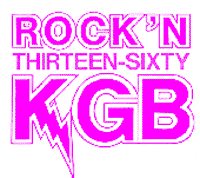
 In March, I received a call from Mike Brown, who along with his father Willet, owned KGB-AM in San Diego. Mike said his dad wanted to meet with me. Willet Brown was a true radio pioneer and great gentleman. One did not turn down an invitation to meet with him. The three of us met at The Brown Derby in Hollywood and the Browns offered me the job as Program Director of KGB, which was in the ratings gutter. It had been on top in the mid-60s when the station closely duplicated the format that Bill Drake and I developed in 1965 when I was the original "Boss" KHJ PD. The Browns were used to being winners. In March, I received a call from Mike Brown, who along with his father Willet, owned KGB-AM in San Diego. Mike said his dad wanted to meet with me. Willet Brown was a true radio pioneer and great gentleman. One did not turn down an invitation to meet with him. The three of us met at The Brown Derby in Hollywood and the Browns offered me the job as Program Director of KGB, which was in the ratings gutter. It had been on top in the mid-60s when the station closely duplicated the format that Bill Drake and I developed in 1965 when I was the original "Boss" KHJ PD. The Browns were used to being winners.
 I told the gentlemen that I was extremely flattered, but was heading back home. They offered me a tidy
sum to spend a few days in San Diego, check out the radio scene and write them a report. This I did.
After reading my report, Mike called me to meet again. After making me an offer I couldn't refuse
(probably the highest PD salary in the country at the time -- double what I was making when I left KHJ),
providing me with a new Cadillac and giving me three weeks off twice a year to visit Maui, I accepted.
Who wouldn't? I told the gentlemen that I was extremely flattered, but was heading back home. They offered me a tidy
sum to spend a few days in San Diego, check out the radio scene and write them a report. This I did.
After reading my report, Mike called me to meet again. After making me an offer I couldn't refuse
(probably the highest PD salary in the country at the time -- double what I was making when I left KHJ),
providing me with a new Cadillac and giving me three weeks off twice a year to visit Maui, I accepted.
Who wouldn't?
 I first had to hire an assistant, which was also part of my deal. Robert W. Morgan had recommended a producer he worked with during his year at WIND in Chicago. This was Rick Leibert, age 22, who happened to be visiting Los Angeles. (Leibert was involved in all our programming moves at KGB and I was most proud, when I finally left there in 1976, that he succeeded me in being named Billboard Magazine Program Director of the Year in our format category.) Rick came up with the name of our successful "Homegrown" LP project, did a lot of the heavy lifting and in his first year at the helm of KGB, created the Skyshows, now an institution in San Diego, which continue to this day. He runs a company called Events Marketing and produces exceptional spectacles. I first had to hire an assistant, which was also part of my deal. Robert W. Morgan had recommended a producer he worked with during his year at WIND in Chicago. This was Rick Leibert, age 22, who happened to be visiting Los Angeles. (Leibert was involved in all our programming moves at KGB and I was most proud, when I finally left there in 1976, that he succeeded me in being named Billboard Magazine Program Director of the Year in our format category.) Rick came up with the name of our successful "Homegrown" LP project, did a lot of the heavy lifting and in his first year at the helm of KGB, created the Skyshows, now an institution in San Diego, which continue to this day. He runs a company called Events Marketing and produces exceptional spectacles.
 After going to San Diego and analyzing the market, I knew that something could be done there but had
nothing specific in mind. I told the Browns that I needed six weeks to do some research--sort of an
unheard of concept back then. Also, the station was losing 40 thousand dollars a month, big bucks back
then, but they gave me a month to do "research" and plot a strategy. After going to San Diego and analyzing the market, I knew that something could be done there but had
nothing specific in mind. I told the Browns that I needed six weeks to do some research--sort of an
unheard of concept back then. Also, the station was losing 40 thousand dollars a month, big bucks back
then, but they gave me a month to do "research" and plot a strategy.
Battle Plan
 I was fortunate to locate Ken Moye, who was in charge of the computer department at San Diego State University. I enlisted his support. (Remember, in those days, there were no CRT computer screens and data had to be entered on punch cards.) Moye also had a background in statistics, was a musician and had worked earlier as a radio announcer. I asked him how large a sample would be required to get an accurate audience response since I did, and still do, consider Arbitron sample sizes
a joke. His reply was one half of one per cent of the population of San Diego County, which equaled around 4000 people. (By comparison, the ARB sample was around 800, if I recall.) I was fortunate to locate Ken Moye, who was in charge of the computer department at San Diego State University. I enlisted his support. (Remember, in those days, there were no CRT computer screens and data had to be entered on punch cards.) Moye also had a background in statistics, was a musician and had worked earlier as a radio announcer. I asked him how large a sample would be required to get an accurate audience response since I did, and still do, consider Arbitron sample sizes
a joke. His reply was one half of one per cent of the population of San Diego County, which equaled around 4000 people. (By comparison, the ARB sample was around 800, if I recall.)
 We conceived a survey in which we asked people about musical tastes, radio listening habits, station
preferences, etc. One of the many tricks I learned from Moye is where to locate people over 18, from
different parts of a market, who will put up with a 10-minute interview. The answer was the DMV. Also,
all surveys were conducted by station employees or their spouses; there was no one paid by the hour to fill them out themselves. We conceived a survey in which we asked people about musical tastes, radio listening habits, station
preferences, etc. One of the many tricks I learned from Moye is where to locate people over 18, from
different parts of a market, who will put up with a 10-minute interview. The answer was the DMV. Also,
all surveys were conducted by station employees or their spouses; there was no one paid by the hour to fill them out themselves.
 After all that was done (and it was way too complex to describe here, but was certainly a forerunner of
focus groups) and the key-punch ladies had entered all the data, Moye, Leibert and I went to the computer department at SDSU after midnight one March night and watched the first printouts come out. We
realized we were looking at information no one had ever quantified to that extent before. It was upon that info--the music part--which we used to begin structuring our music format. After all that was done (and it was way too complex to describe here, but was certainly a forerunner of
focus groups) and the key-punch ladies had entered all the data, Moye, Leibert and I went to the computer department at SDSU after midnight one March night and watched the first printouts come out. We
realized we were looking at information no one had ever quantified to that extent before. It was upon that info--the music part--which we used to begin structuring our music format.
 I was given free rein with one exception, the same as at KHJ: Don't change the call letters. I contemplated a way to establish a new identity while taking advantage of KGB's "brand name." Environmental consciousness had begun to stir by then as people were becoming aware of such things, so I got the idea to "recycle" the entire radio station. All over town we posted notices made to look official and cold, which read: I was given free rein with one exception, the same as at KHJ: Don't change the call letters. I contemplated a way to establish a new identity while taking advantage of KGB's "brand name." Environmental consciousness had begun to stir by then as people were becoming aware of such things, so I got the idea to "recycle" the entire radio station. All over town we posted notices made to look official and cold, which read:
PUBLIC NOTICE:
Radio Station K.G.B. will be recycled
on April 2, 1972.
 We ran these as small ads in the newspaper legal announcements . And on KGB's air, we ran a track with only that same wording between every few records. We spent very little money, but most people in town knew by April 2 that something would be happening at 1360 on the AM dial. We ran these as small ads in the newspaper legal announcements . And on KGB's air, we ran a track with only that same wording between every few records. We spent very little money, but most people in town knew by April 2 that something would be happening at 1360 on the AM dial.
 Back in 1959, when we changed KHON into K-POI and created Hawaii's first and probably greatest rock station, we ran the same horrible record continuously for 24 hours to attract attention. (Also, this silly, prolonged attention-getter allowed us to do many last-minute things behind the scenes. Listening to the KGB Recycle Doc for two days got to be very psychedelic after a while.) Back in 1959, when we changed KHON into K-POI and created Hawaii's first and probably greatest rock station, we ran the same horrible record continuously for 24 hours to attract attention. (Also, this silly, prolonged attention-getter allowed us to do many last-minute things behind the scenes. Listening to the KGB Recycle Doc for two days got to be very psychedelic after a while.)
 I decided to do a repetitive piece for the changeover in San Diego. But not just a dumb record played over and over. It would be a quasi-documentary that was really part put-on, part put-down, part promo and hopefully, compelling radio. (In an odd way, it might have been a mis-infommercial.) I decided to do a repetitive piece for the changeover in San Diego. But not just a dumb record played over and over. It would be a quasi-documentary that was really part put-on, part put-down, part promo and hopefully, compelling radio. (In an odd way, it might have been a mis-infommercial.)
 I also not only wanted to bust out of the rigid Boss Radio strictures that had begun to bore me to death, but I wanted to do some tongue-in-cheek narrative and production work after playing it so straight with "The History of Rock and Roll" and "The Elvis Presley Story." Those epics were written by Pete Johnson and Jerry Hopkins, respectively. They were fantastic scripts, but like the KHJ/Boss Format, I thought everyone, including me, had started to take it all a bit too seriously. Besides, this "recycle thing" was just an extended promo, to be heard one weekend in one market. I also not only wanted to bust out of the rigid Boss Radio strictures that had begun to bore me to death, but I wanted to do some tongue-in-cheek narrative and production work after playing it so straight with "The History of Rock and Roll" and "The Elvis Presley Story." Those epics were written by Pete Johnson and Jerry Hopkins, respectively. They were fantastic scripts, but like the KHJ/Boss Format, I thought everyone, including me, had started to take it all a bit too seriously. Besides, this "recycle thing" was just an extended promo, to be heard one weekend in one market.
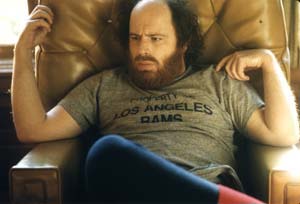 |
| Ron Jacobs contemplates quarter-hours and quarterbacks, La Jolla, 1972. |
PHOTO BY LONGTIME FRIEND AND
ROCK PHOTOGRAPHER HENRY DILTZ |
 I took inventory of what elements we had, what we could come up with, and started writing the copy with no particular length in mind, just as long as it ended with a plug for the new format and a production effect that would be "the sound of a bird flying up its own butt," since to the listener tuning in there was no obvious start or finish. I took inventory of what elements we had, what we could come up with, and started writing the copy with no particular length in mind, just as long as it ended with a plug for the new format and a production effect that would be "the sound of a bird flying up its own butt," since to the listener tuning in there was no obvious start or finish.
 With a completed script that positioned all the ingredients we had assembled, I drove up to Watermark in L.A. (On the way up and back I lowered the Caddy's window to thrust my middle finger at Richard Nixon's "Western White House" in San Clemente, part of a regular ritual involved in driving regularly to L.A. to see the Rams.) With a completed script that positioned all the ingredients we had assembled, I drove up to Watermark in L.A. (On the way up and back I lowered the Caddy's window to thrust my middle finger at Richard Nixon's "Western White House" in San Clemente, part of a regular ritual involved in driving regularly to L.A. to see the Rams.)
The Production Crew
 I assembled the piece at Watermark, because by then there was a custom 8-track board. Also, I felt comfortable there, having done the first "American Top 40" show with Casey Kasem in that tiny studio as well as spending many hours with Wink Martindale there when he voiced the 12-hour Elvis program.
The engineer was Bill Hergonson (later to become a KGB jock.) He recalls, I assembled the piece at Watermark, because by then there was a custom 8-track board. Also, I felt comfortable there, having done the first "American Top 40" show with Casey Kasem in that tiny studio as well as spending many hours with Wink Martindale there when he voiced the 12-hour Elvis program.
The engineer was Bill Hergonson (later to become a KGB jock.) He recalls,
"I was in Pasadena. You called me from San Diego and said to sleep in your empty house in Laurel Canyon. I remember there was a water bed on the floor, a blanket and a copy of the 'Child's Garden of Grass' book. I met you and Michael Gwynne at the studio the next morning and we did it in about four hours."
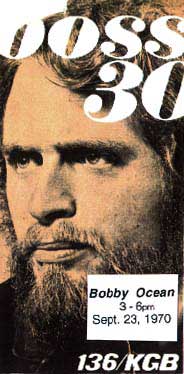 | | PHOTO: ELIZABETH SALAZAR |
 The opening FX voice is that of Bobby Ocean, one of the absolute best production people with whom I ever worked. I remember at one point calling in Ocean and asking him to, "Put together a few minutes of songs with socially significant lyrics." He said "OK" and came back an hour later with a collage that to this day gives me chills when I hear it. (Even more so when considering it was done with a razor blade and on 2-track machines.) Later, in L. A., the music changes in that collage were run through a custom phaser that had been built, as had all of Watermark's original gear, by David Freese of Hanley Sound, who would go on to handle the sound at Woodstock. There was little audio processing available then, especially in non-music studios, and we all thought those segues were "far out, man." The opening FX voice is that of Bobby Ocean, one of the absolute best production people with whom I ever worked. I remember at one point calling in Ocean and asking him to, "Put together a few minutes of songs with socially significant lyrics." He said "OK" and came back an hour later with a collage that to this day gives me chills when I hear it. (Even more so when considering it was done with a razor blade and on 2-track machines.) Later, in L. A., the music changes in that collage were run through a custom phaser that had been built, as had all of Watermark's original gear, by David Freese of Hanley Sound, who would go on to handle the sound at Woodstock. There was little audio processing available then, especially in non-music studios, and we all thought those segues were "far out, man."
 Ocean included in one of his elements the "Boss Radio" bit ("...the music that the boss tells me to play") from an early George Carlin album. Bobby produced the "School of Broadcasting Intro" and "Jock Meeting" material for audio skits he originally created for a Programming Seminar put on by Bob Hamilton (the publisher, not the PD) and his buddy Buzz Bennett. At that time, Ocean was doing mid-days at KCBQ and Bennett was the PD. Ocean can't recall if he did this material for the first seminar in San Carlos (north of San Diego) in the Spring of 1970, or the second one at Whistler's Mountain in the Fall of 1970. Ocean included in one of his elements the "Boss Radio" bit ("...the music that the boss tells me to play") from an early George Carlin album. Bobby produced the "School of Broadcasting Intro" and "Jock Meeting" material for audio skits he originally created for a Programming Seminar put on by Bob Hamilton (the publisher, not the PD) and his buddy Buzz Bennett. At that time, Ocean was doing mid-days at KCBQ and Bennett was the PD. Ocean can't recall if he did this material for the first seminar in San Carlos (north of San Diego) in the Spring of 1970, or the second one at Whistler's Mountain in the Fall of 1970.
 About those events, Ocean writes: About those events, Ocean writes:
"That was the gathering planned with the most hippie idealism. I seem
to remember they were paying homage (although arrogantly) to their inspiration, Bill Gavin. They had their first 'awards ceremony' at which cheap plastic gold-plated trophy cups were presented to every soul in attendance, instead of leaving anyone out."
 Regarding the intro (which launches the Recycle Documentary), Ocean says, Regarding the intro (which launches the Recycle Documentary), Ocean says, "I tried to sound mechanically cartoonish. The 'staff meeting' was from another part of the presentation, which also was never for air, but rather the seminar audience. We were poking fun at ourselves during the era of Omnipotent Format. In those days we lived at the station. Among the other voices included are Rich Brother Robbin and Chuck Browning. We were baby broadcasters with Rolling Stones ambitions, and we
were showing off. We were poking fun at the established order. This made us admirably dangerous and
sexually appealing, or so we thought."
 Ocean is still at it, producing Numero Uno stuff for select stations. Ocean is still at it, producing Numero Uno stuff for select stations.
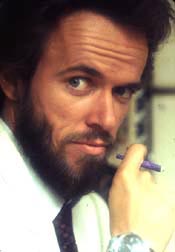 |
| Former DJ Michael Gwynne, in 1972. Most recently, he appeared in Howard Stern's "Private Parts". |
| PHOTO: HENRY DILTZ |
 The "History of Rock and Roll" was influenced by NBC's "Biographies in Sound," which I studied in the mid-50's while at KGU. Robert W. Morgan's talent as a 'straight' announcer fit the KHJ show perfectly. For the overall narrator of the KGB production I wanted someone with radio experience but who could also take subtle direction, since I considered the project a tongue-in-cheek affair.
In my mind I heard John Facenda's classic narration of NFL film highlights; how menacing it sounded when a team went to play in "the frozen tundra" of Green Bay. The "History of Rock and Roll" was influenced by NBC's "Biographies in Sound," which I studied in the mid-50's while at KGU. Robert W. Morgan's talent as a 'straight' announcer fit the KHJ show perfectly. For the overall narrator of the KGB production I wanted someone with radio experience but who could also take subtle direction, since I considered the project a tongue-in-cheek affair.
In my mind I heard John Facenda's classic narration of NFL film highlights; how menacing it sounded when a team went to play in "the frozen tundra" of Green Bay.
 I was lucky to know Michael Gwynne, who had worked at K-POI after I left Honolulu. Following jock stints in New York and the Bay Area, Gwynne turned to acting. He had already appeared in several films, usually as a scowling detective, when we met at the original Watermark Studios in late-March 1972 to cut the tracks for the KGB Recycle production. Gwynne did, and does, possess some of the best pipes I've ever heard and I wrote the narration with his voice and style in mind. People have been very favorable about the copy, but without Mike's fantastic line readings, it would have turned out much less effective. I was lucky to know Michael Gwynne, who had worked at K-POI after I left Honolulu. Following jock stints in New York and the Bay Area, Gwynne turned to acting. He had already appeared in several films, usually as a scowling detective, when we met at the original Watermark Studios in late-March 1972 to cut the tracks for the KGB Recycle production. Gwynne did, and does, possess some of the best pipes I've ever heard and I wrote the narration with his voice and style in mind. People have been very favorable about the copy, but without Mike's fantastic line readings, it would have turned out much less effective.
Liner Notes
 The bit about "Radio K.A.O.S." is from a single called "Chaos Parts 1 & 2" by Arbogast and Ross on Liberty Records. (Hey, don't think I remember that one; I had to call my old friend Dr. Demento for the details.) The bit about "Radio K.A.O.S." is from a single called "Chaos Parts 1 & 2" by Arbogast and Ross on Liberty Records. (Hey, don't think I remember that one; I had to call my old friend Dr. Demento for the details.)
 Regarding Bob Reagan's, "KGB Pulsebeat" announcement, there was an old ET lying around that had that moment preserved on it. I can't verify when ground was broken for those studios on Pacific Coast Highway, but it was before the freeway bypassed the station. From the decor and architecture, I would guess somewhere in the mid to late 50s. Regarding Bob Reagan's, "KGB Pulsebeat" announcement, there was an old ET lying around that had that moment preserved on it. I can't verify when ground was broken for those studios on Pacific Coast Highway, but it was before the freeway bypassed the station. From the decor and architecture, I would guess somewhere in the mid to late 50s.
 Richard Irwin has asked me, "Right after 'radio's once powerful voice became a whisper' there is a clip of someone laughing uncontrollably about Phil Harris. I am woefully ignorant as to the source of this clip." I wanted something to illustrate how radio had descended to the sound of people talking to themselves, laughing at their own jokes, "playing to the room"--not unlike today in many instances, unfortunately --and I found this track on one of those classic "Blooper" albums. It is deliberately there to be confusing and inaudible. Jay Marks (see
"Comment" below) has identified the "someone laughing" as veteran newscaster Lowell Thomas. Richard Irwin has asked me, "Right after 'radio's once powerful voice became a whisper' there is a clip of someone laughing uncontrollably about Phil Harris. I am woefully ignorant as to the source of this clip." I wanted something to illustrate how radio had descended to the sound of people talking to themselves, laughing at their own jokes, "playing to the room"--not unlike today in many instances, unfortunately --and I found this track on one of those classic "Blooper" albums. It is deliberately there to be confusing and inaudible. Jay Marks (see
"Comment" below) has identified the "someone laughing" as veteran newscaster Lowell Thomas.
 All the "Cruisin'" LP tracks were recorded by the jocks in 1970 for that series of recreated shows..
Joe Niagara, WIBG Philadelphia, 1957;
Dick Biondi, WKBW Buffalo, 1960;
B. Mitchell Reed, WMCA New York, 1963.
The jingles were in use at the time of the jock's "Cruisin'" year, but as to when they were recorded, all I can tell you is that it would have been, obviously, sometime prior. All the "Cruisin'" LP tracks were recorded by the jocks in 1970 for that series of recreated shows..
Joe Niagara, WIBG Philadelphia, 1957;
Dick Biondi, WKBW Buffalo, 1960;
B. Mitchell Reed, WMCA New York, 1963.
The jingles were in use at the time of the jock's "Cruisin'" year, but as to when they were recorded, all I can tell you is that it would have been, obviously, sometime prior.
 Hergonson recalls that I hauled in a bunch of LP's and the tapes produced in San Diego. Since I wanted to make the overarching background music the antithesis of typical rock radio "production music," I brought along a copy of the soundtrack from "A Clockwork Orange," with Walter Carlos' synthesizer-enhanced versions of Beethoven's Ninth Symphony, "Pomp and Circumstance" by Elgar and Rossini's "William Tell Overture."
Another album was called "Harvard Strikes," which chronicled the student riots and, as it turned out, Hergonson had worked on it in 1968. Hergonson recalls that I hauled in a bunch of LP's and the tapes produced in San Diego. Since I wanted to make the overarching background music the antithesis of typical rock radio "production music," I brought along a copy of the soundtrack from "A Clockwork Orange," with Walter Carlos' synthesizer-enhanced versions of Beethoven's Ninth Symphony, "Pomp and Circumstance" by Elgar and Rossini's "William Tell Overture."
Another album was called "Harvard Strikes," which chronicled the student riots and, as it turned out, Hergonson had worked on it in 1968.
 The Recycle Documentary was recycling stuff on audio tape 25 years ago and now it is being re-recycled worldwide on the Internet, a concept that was inconceivable to us at the time (other than Marshall McLuhan's predictions, of course.) The Recycle Documentary was recycling stuff on audio tape 25 years ago and now it is being re-recycled worldwide on the Internet, a concept that was inconceivable to us at the time (other than Marshall McLuhan's predictions, of course.)
Off and Running
 I sensed we were assembling some different kind of animal as we put the thing together. We mixed it down. I took the quarter-inch master and headed back down to 4141 Pacific Coast Highway, San Diego. Listening to the competition, KCBQ, KDEO and KPRI, I hoped that the innocent-looking 10-inch box sitting on the red leather seat of my new 1972 Cadillac Coupe DeVille held the radio-active object that would trigger their downfall. I sensed we were assembling some different kind of animal as we put the thing together. We mixed it down. I took the quarter-inch master and headed back down to 4141 Pacific Coast Highway, San Diego. Listening to the competition, KCBQ, KDEO and KPRI, I hoped that the innocent-looking 10-inch box sitting on the red leather seat of my new 1972 Cadillac Coupe DeVille held the radio-active object that would trigger their downfall.
 My final thought, looking back after Wow-25-Years: You're only as good as those you are up against. That's what Bill Drake and I learned in 1962's "Battle of Fresno." Regarding KGB, credit must be given to Buzz
Bennett who had built a formidable 50,000 watt powerhouse at KCBQ and was aided tremendously by
Jack McCoy's "Last Contest," perhaps the toughest AM promotion I ever ran up against. By August of 1972, KGB began simulcasting full-time (courtesy of a neat little scam we pulled on the FCC.) We then had to deal with KPRI, one of the first "underground" stations on the West Coast, coming on the heels of KMPX in San Francisco (Tom Donahue's creation, bless his soul) and KPPC in Pasadena. We also had our hands full when Mike Harrison arrived at KPRI, where he coined the phrase "AOR." My final thought, looking back after Wow-25-Years: You're only as good as those you are up against. That's what Bill Drake and I learned in 1962's "Battle of Fresno." Regarding KGB, credit must be given to Buzz
Bennett who had built a formidable 50,000 watt powerhouse at KCBQ and was aided tremendously by
Jack McCoy's "Last Contest," perhaps the toughest AM promotion I ever ran up against. By August of 1972, KGB began simulcasting full-time (courtesy of a neat little scam we pulled on the FCC.) We then had to deal with KPRI, one of the first "underground" stations on the West Coast, coming on the heels of KMPX in San Francisco (Tom Donahue's creation, bless his soul) and KPPC in Pasadena. We also had our hands full when Mike Harrison arrived at KPRI, where he coined the phrase "AOR."
 Although being a consistent ratings leader, KGB has not been given the recognition over the years for continuous quality entertainment and breaking new ground. I consider it right up there with anything I was lucky enough to have worked on. Although being a consistent ratings leader, KGB has not been given the recognition over the years for continuous quality entertainment and breaking new ground. I consider it right up there with anything I was lucky enough to have worked on.
 Our first huge promotion happened on November 12, 1972, when more than 50,000 fans filled San Diego Stadium, the largest concert crowd in
California at the time. For $1.01, with all profits going to charity, KGB listeners saw the J. Geils Band, Quicksilver Messenger Service, Foghat, Dr. Hook's Medicine Show, Jesse Collin Young and others. From a newspaper account: "There's a word the kids use these days called 'vibes.' What vibes means is feeling, atmosphere, mood. The vibes this day were good." Our first huge promotion happened on November 12, 1972, when more than 50,000 fans filled San Diego Stadium, the largest concert crowd in
California at the time. For $1.01, with all profits going to charity, KGB listeners saw the J. Geils Band, Quicksilver Messenger Service, Foghat, Dr. Hook's Medicine Show, Jesse Collin Young and others. From a newspaper account: "There's a word the kids use these days called 'vibes.' What vibes means is feeling, atmosphere, mood. The vibes this day were good."
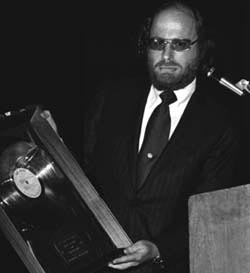 |
| Ron Jacobs receives a gold copy of KGB's HOMEGROWN album in 1973. Profits from the sale of 30,000 albums were donated to the United Way. |
| PHOTO: RUSS PULS |
 The first "Homegrown" album was released in 1973. It featured local musicians performing their songs about the area, cover art by a San Diegan and liner notes by a teenage KGB listener named Cameron Crowe. The album sold more copies locally than Led Zeppelin's "Stairway To Heaven" LP, the year's #1 record, and became an annual tradition. The first "Homegrown" album was released in 1973. It featured local musicians performing their songs about the area, cover art by a San Diegan and liner notes by a teenage KGB listener named Cameron Crowe. The album sold more copies locally than Led Zeppelin's "Stairway To Heaven" LP, the year's #1 record, and became an annual tradition.
 And would there be any crazy sports mascots running around today if not for the original KGB Chicken? And would there be any crazy sports mascots running around today if not for the original KGB Chicken?
by Ron Jacobs
Burbank, California, 1997
whodaguy@lava.net
 Michael Gwynne is represented by the Paradigm Agency, New York.
Michael Gwynne is represented by the Paradigm Agency, New York.
Contact Jeb Bernstein, (212) 246-1030.
Ron Jacobs wishes to acknowledge his computer gurus Frank Mullin and Ray Randolph.
Ray is the unofficial 93/KHJ Boss Radio archivist.
SPECIAL THANKS TO: John Barcroft, Mark Chetverikov, Dr. Demento, Henry Diltz, Bill Hergonson, Rick Leibert, Randy Massey, Bobby Ocean, Russ Puls, Tom Rounds, and Elizabeth Salazar.

Return to the Ron Jacobs Collection Biography and Menu
© 1997-2007 Ronald H. Jacobs
|




